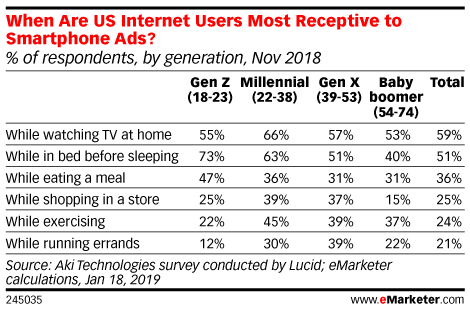|
Getting your Trinity Audio player ready...
|
New subscription tools, the GateHouse Gannett merger, top publishers on Facebook, and the continued importance of SMS and obituaries.
Here’s our regular round-up of the Top 10 stats from the past month:
1: US newspaper giants GateHouse and Gannett in $1.4B merger
Two of the largest newspaper groups in the United States, GateHouse Media and Gannett, announced merger plans, which would create the US’ largest newspaper group.
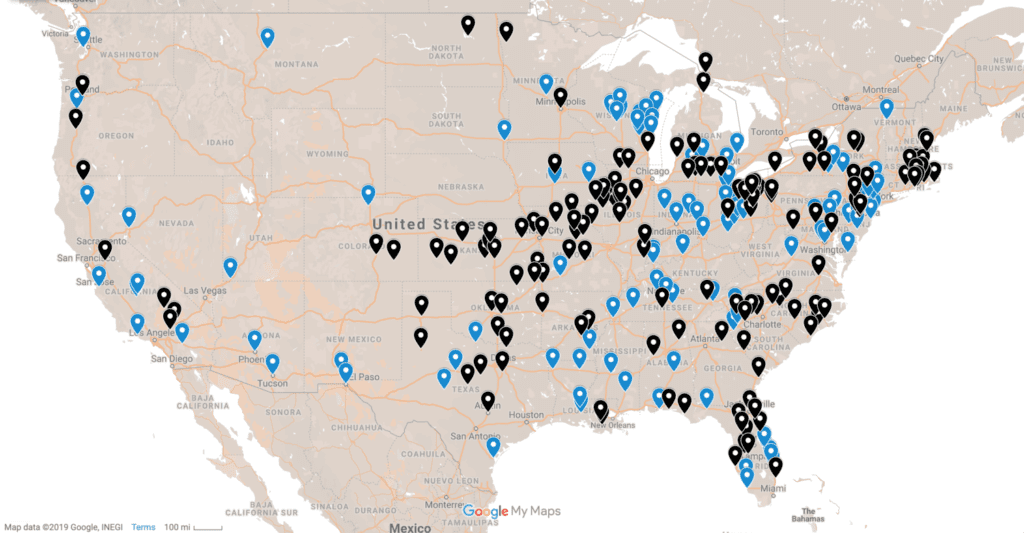
“Both GateHouse and Gannett are known as buyers of other papers,” notes AP. “Bulking up lets companies cut costs — via newsroom layoffs and other measures — and centralize operations. The combined company would have more than 260 daily papers in the U.S. along with more than 300 weeklies.”
To help finance the deal, Ken Doctor explains, GateHouse are using a $1.792 billion “bridge loan.” “As a bridge, it’s a costly one,” he notes, “set at 11.5 percent interest…the best rate Gatehouse could get to get the deal done now. One reason that bigger Gannett isn’t the acquirer: it didn’t have the juice to get the financing.”
AP reminds us that this deal – which will see the new company keep the Gannett name – comes against a backdrop whereby: “According to a study by the University of North Carolina, the U.S. has lost almost 1,800 local newspapers since 2004. Newsroom employment fell by a quarter from 2008 to 2018, according to Pew Research, and layoffs have continued this year.”
With promises to save $300 million a year, these numbers may well be added to. After all, as Doctor observes:
“For a company whose revenue is only about 25 percent digital, the massive heavy lifting of “digital transformation” lies ahead…The new Gannett is much closer to the beginning of the digital transformation process than the end. That’s expensive.”
2: Obituaries worth $500 million a year to local US newspapers
Axios shared data from Adpay, an advertising placement firm owned by Ancestry.com., that obituaries generate around $500 million a year for local newspapers in the US.
“For context,” they note, “the newspaper market in the U.S. brings in roughly $25 billion in advertising and subscriptions combined.” More than a million paid obituaries created annually.
“Obits, alongside public notice ads, are one of the last remaining consistent revenue streams that local newspapers rely on, although both are being challenged by the digital age,” authors Sara Fischer, Alison Snyder write. Social media, other obiturary services, and “the rise of free death notices” are all potential threats to this revenue stream.
3: In 2021, consumers will spend over three hours a day online
According to the Zenith Media Consumption Report ($), and shared on these pages by FIPP, media consumers worldwide will spend 170 minutes on the internet each day. In two years time, this will have increased by another 22 minutes, to 192 mins a day.
In contrast, at the start of the decade daily time worldwide with print newspaper stood at just over 20 minutes. This is projected to drop to nine minutes a day by 2021; more than half the figure in 2011.
Time with print magazines is also dropping at a similar rate, down from c. 10 minutes a day in 2011, to around four minutes per day in 2021.

4: 16-34s in the UK spend 64 mins a day watching YouTube
Just under half of UK homes now subscribe to TV streaming services, Ofcom, the UK communications regulator, revealed. The number of UK households subscribed to the most popular streaming platforms – Netflix, Amazon Prime Video, Now TV and Disney Life – increased to 13.3m (47%) in 2019, up from 11.2m (39% of households) the year before.
“With many homes using more than one service, the total number of UK streaming subscriptions increased from 15.6m to 19.1m in 2018,” the regulator noted.
Although young adults (those aged 16-34) watch 83 minutes of Live TV a day – the most popular type of video consumption – they now spend an average of 64 mins a day watching YouTube on non-TV screens. This is more than the time they spend on subscription video on demand (SVoD).
Of the 4 hours 34 mins this group spends, on average, watching video content less than half – only 42% – is to broadcast media.

5: CNN and Fox are the top publishers on Facebook
NewsWhip’s monthly round-up of publisher engagement highlighted that – as in June 2019 – the top two publishers on Facebook were CNN and Fox.
Both publishers enjoyed more than 50 million engagements on the social network, some way ahead of the Daily Mail at 33.8 million. Compared to their rivals, however, The Mail, produced more than 10 x the number of Facebook posts.
“CNN’s success was driven by a variety of stories,” notes Managing Editor Benedict Nicholson. “The top article for the publisher was about see-saws being installed by artists at the U.S.-Mexico border so that children could play together,” he wrote, while “Fox was, as usual, driven mainly by political stories, or culture stories seen through a political lens.”
That said, neither publisher had the top story of the month. That belonged to the Independent, who netted more than two million engagements for a feature on gardens being created for honeybees on top of bus stops in Utrecht.
“Worthy of particular note in this month’s rankings were HuffPost and the Washington Post, which climbed to fourth and fifth in our rankings respectively,” Nicolson says.
“Both have been climbing consistently since the start of the year, with the Washington Post having climbed from 17th to 4th over the course of six months by rising a few places every month.” WaPo’s Facebook strategy, therefore, may be one to watch.
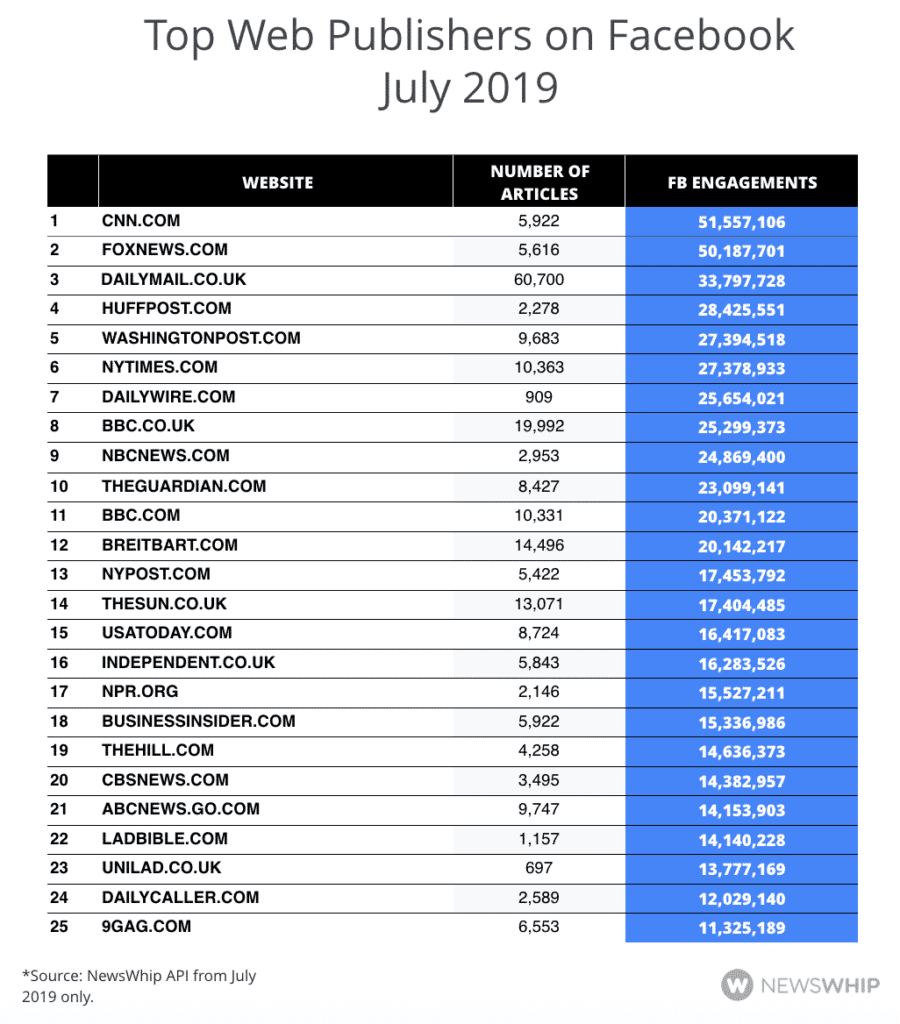
6: Quibi to release 7,000 pieces of short-form content in Year One
With new content from Steven Spielberg, Guillermo del Toro, Antoine Fuqua, Jason Blum, Jennifer Lopez, Tyra Banks, Rashida Jones, Anna Kendrick and others, Quibi’s holding page says:
Something cool is coming from Hollywood and Silicon Valley — quick bites of captivating entertainment, created for mobile by the best talent, designed to fit perfectly into any moment of your day.
According to the Hollywood Reporter, the company already has “$1 billion in the bank and a goal of releasing some 7,000 pieces of content during Quibi’s first year.”
The company is led by the Former chairman of the Walt Disney Company and former co-founder and CEO of DreamWorks Animation and DreamWorks Records, Jeffrey Katzenberg; with for eBay and Hewlett Packard President and CEO Meg Whitman as their CEO.
Fortune reports that “Katzenberg and Whitman have sold the idea as a mobile-based Netflix of sorts and have earned the backing of major Hollywood players, including Disney, NBCUniversal, Sony, Viacom, and AT&T’s newly-rebranded WarnerMedia.”
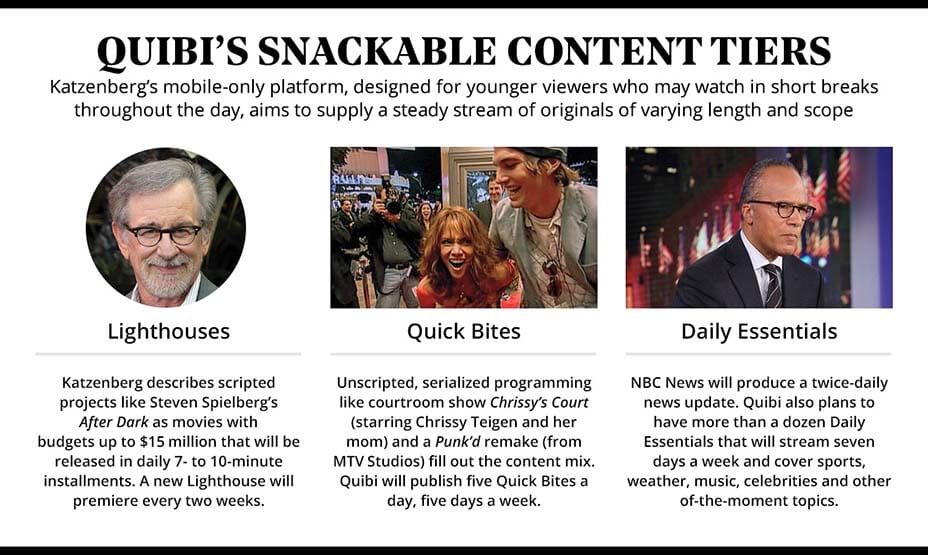
7: Texting most common media activity in emerging markets
A new survey from the Pew Research Center, found that in 11 emerging economies around the world, “smartphone users – and especially those who use social media – are more regularly exposed to people who have different backgrounds and more connected with friends they don’t see in person. Those with smartphones are also more likely to have accessed new information about health and government services.”
For publishers and content creators, a key takeaway from the research was the on-going popularity of text messaging.
As Andrew Hutchinson comments for Social Media Today:
“Part of that, of course, comes down to connectivity and network capacity – many users in these markets are on restrictive data plans, which could limit their capability to fully utilize social media tools and apps. But then again, the numbers show that they are still taking pictures and video, and sending them via message. if you were in any doubt as to where the future of digital interaction lies, these results likely show that messaging is the way to go.”
“For brands, that means messaging is a key area to explore, especially if you’re looking to reach new markets,” he adds. “Tools like chatbots, and apps like WhatsApp, could be key to this expansion, and it’s worth considering how they might fit into your broader digital strategy.”
Closer to home, Project Text, an initiative from the US media group Advance Local, is putting these principles into action. Readers can opt-in to texts from journalists covering specific beats. “When readers can choose what stories they receive on their phones, they are more likely to open the message, engage with the content and even come up with further leads, writes journalism.co.uk’s Daniel Green.
“Hosts can charge subscribers a monthly fee for receiving texts, normally between $3.99 and $6.99 (£3.30 and £5.80), with revenue split between the host and Advance Local.”
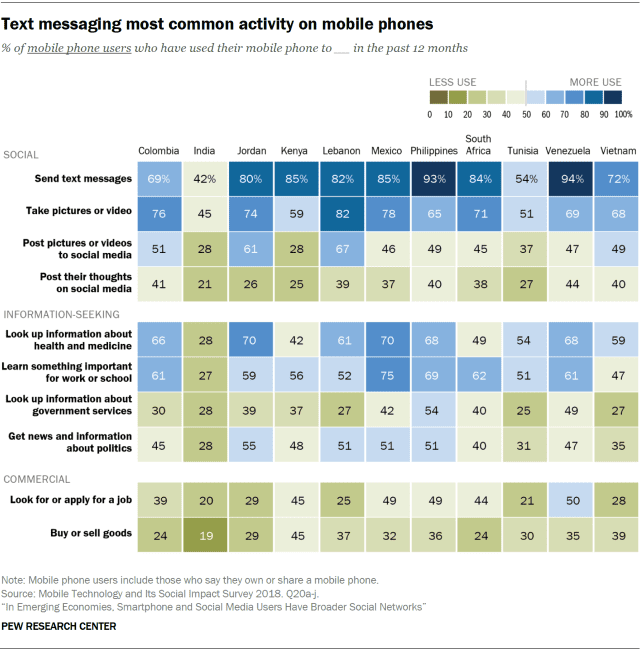
8: Austin, Texas, is the U.S. streaming capital
“Compared with just two years ago, 40 million more Americans are streaming content to their TV sets,” Nielsen, a research company, found in the latest edition of their Local Watch Report. The study, which dives deep into streaming behaviours found that 134.2 million (56%) of U.S. adults streamed non-linear video to their TV set in May 2019.
“As reach continues to grow,” they observe, “frequency is increasing as well.” Subsequently, “the average adult now spends 11 days streaming each month (up from nine days in 2017) and they’re spending more minutes per viewing session.” On average, US streamers consume 2 hours 4 mins of content this way, up from 1 hour 52 mins two years ago.
Austin, Texas, topped the streaming charts with 7 out of 10 adults having streamed content in May 2019. The cities of Cincinnati, Salt Lake City and San Diego are followed closely behind.
“Streamers spend two hours and 32 minutes watching broadcast and cable, while non-streamers spend a whopping four hours and 26 minutes,” the authors note, reinforcing the continued importance of TV as a medium for brands. “That is a big window of time to reach consumers with your advertisements.”
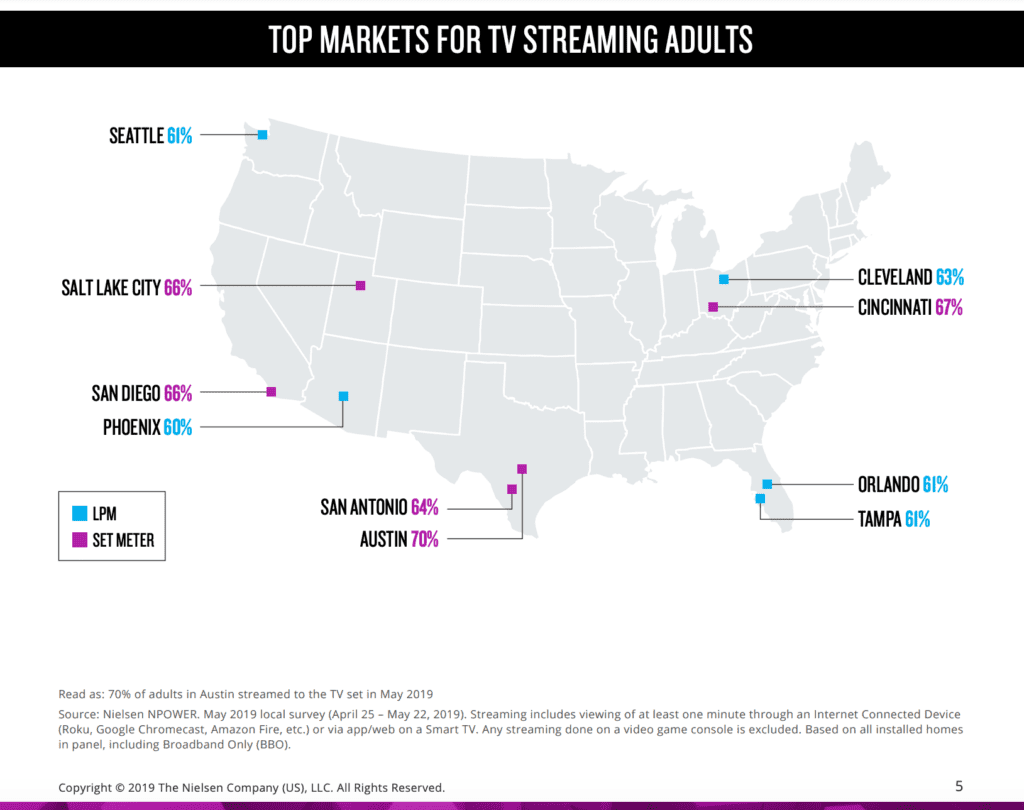
9: Publishers see 30% uplift in subscriptions, via ‘Subscribe with Google’
Publishers, including The Washington Post, The New York Times and the Financial Times, have reported seeing an uptick in subscriptions after rolling out efforts allowing consumers to buy a news subscription, using their Google account.
Google explained, in a blog post last year, how it works.
Subscribe with Google lets you buy a subscription, using your Google account, on participating news sites. Select the publisher offer you’d like to buy, click “Subscribe,” and you’re done. You’ll automatically be signed in to the site, and you can pay–securely and privately—with any credit card you’ve used with Google in the past. From then on, you can then use “Sign In with Google” to access the publisher’s products, but Google does the billing, keeps your payment method secure, and makes it easy for you to manage your subscriptions all in one place.
As What’s New In Publishing’s Monojoy Bhattacharjee recently shared, “After months of testing, more publishers have now started rolling out their offerings with ‘Subscribe with Google’, and in the initial stages, there’s some unheard of offers up for grabs, like the Financial Times’ “6 months free” trial.”
We can expect more publishers to explore the possibilities afforded by this initiative, as efforts to simplify – and drive – subscriptions continue to evolve.
10: Smartphone ads best targeted at TV viewers and people about to go to bed
An article by eMarketer on Gen X’s Digital Device Usage and Attitudes Towards Advertising also contained useful insights on receptiveness to smartphone ads for all demographics.
The research found that across all age groups, American internet users were most receptive to smartphone ads “while watching TV at home” and “while in bed before sleeping.”
Younger audiences, Gen Z (those aged 18-23) were also more open to ads while eating a meal, but less so while exercising, shopping or running errands.
“Xers are very open to interacting with media in new ways, whether that’s the smartphone, the smart speaker, streaming, etc.” they quote Deloitte’s executive director for technology, media and telecommunications, Jeff Loucks, as saying.
Although talking about Gen Xers, but offering advice which is arguably applicable to all demographics, Loucks said: “They are eager for a better ad experience, and they want a better exchange of attention for content.”
